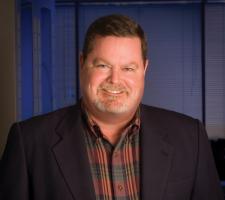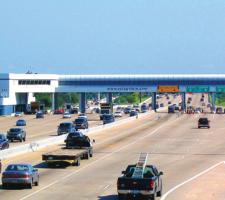
Is US tolling as fragmented and divided as some would have you believe? And are the technology suppliers so very entrenched? ITS International spoke to the market's leading suppliers
Is US tolling as fragmented and divided as some would have you believe? And are the technology suppliers so very entrenched? ITS International spoke to the market's leading suppliers
A few years back, the prevalent view was that the North American tolling market was characterised by fragmented, proprietary solutions, each existing in splendid isolation. The reality is that a combination of pragmatism and good old market forces have seen some concerted moves made towards interoperability in many areas.Critics have often said that tolling system buyers and operators are hostage to the selfish commercial interests of the equipment manufacturers and suppliers, but is this wholly true?
ITS International recently conducted a survey of the major suppliers and asked them to explain their product ranges, their development philosophies and how they viewed market development. Interestingly, despite some commonly held views of one manufacturer or another being the champion of one or another tolling technology, all claimed to be technology-agnostic. Significantly, many claimed to be 'unique' by virtue of the breadth of the offering they make to the market and the ability to supply tightly integrated, end-to-end solutions.
A tipping point
Market acceptance of multiprotocol RFID technology reached a tipping point with North Carolina Turnpike Authority's selection of multiprotocol eGo Plus/eZGo Anywhere tags and Encompass readers, says"The eGo Plus RFID family, from windshield sticker tags to hard-cased HOV/HOT switchable tags, remain our latest offerings. With multi-protocol Encompass readers that can read/write to every North American protocol, they provide a path to national and regional interoperability in the US.
"Acquiring United Toll Systems in 2009 significantly expanded our technology portfolio and many customers have already chosen to upgrade to the state-of-the-art Infinity lane solution. We continue to develop our Customer Account Management System to support back-office needs as diverse as a single two-lane bridge up to ORT systems spanning many lanes and hundreds of thousands of processes per day." Solutions have to offer a solid business case, he feels: "Many others have tried to import technologies from outside tolling but these simply don't provide the necessary real-time speed, accuracy and security. We'll remain focused on multi-protocol technology that allows both legacy and next-generation ETC technologies to co-exist. Modularity makes adding or changing protocols simple, fast and adaptable and battery-free onboard products reduce cost, problems and maintenance. Multi-protocol readers also mean it'll be simple to install a DSRC module when standards become stable and if DSRC becomes the next-generation solution.
"We continue to invest in both RFID and video because we see a role for both. Video's accuracy is still well behind RFID's in real-world applications but the technology has made significant strides and the unique algorithms in our VCARS and PPS solutions are state of the art.
"Our primary differentiator is simply the breadth of services and products we offer. For example, the companies that compete for customer service operations are completely different from those that compete to provide the RFID technology; those that provide in-lane tolling technology do not provide the integration services. This breadth of capabilities allows TransCore to provide a comprehensive, tightly integrated solution, reducing risk, cost and schedule.
"Secondly, we believe in driving costs out and passing the savings on while retaining a high level of performance, so our SeGo tags in the $10 range perform as well as or better than competitors' $20-plus tags and have significantly higher performance than low-cost 6C tags. Part of that higher performance is the communication security inherent in our recent products. Our E6 line of readers allows agencies to support multiple tag types with one reader, whether they are transitioning their own tag population or looking to read a neighbouring agency's.
"Customers aren't shy. They say exactly what they want and need. However new policy direction is anything but clear. For starters, policymakers exist in so many places. Federal, regional and local governments are involved, as are radio regulators, user groups, technology alliances and so on. Their views aren't harmonised but a few things are becoming obvious.
"Everyone wants interoperability - at all levels. Many agencies have technology in place that would require a significant investment to change to a single ETC standard. Therefore, in the area of interoperability, the policy aspirations and the wants/needs of the customers are oftentimes in conflict due to the investment required and the potential disruption to the existing customer base. That's driven our multiprotocol approach.
"Privacy and anonymity are becoming more important. Malicious mischief is on the rise, making communication security an important item in new tolling systems. This is a real and increasing threat and it will be hard to deal with in a multi-million tag deployment. TransCore has incorporated numerous security features (including an encryption engine) into its products and this is another real discriminator for us."
DSRC, or not to be
"No-one knows what the next generation of tolling technology will be. DSRC is a possibility if point tolling continues to be the norm. VMT systems may instead be the 'next big thing'. Either way, current tolling operators face a scary migration exercise. TransCore's modular technology is well equipped to make that as painless as possible."Since the future technology path and associated transition timeline are unclear, most toll agencies have no choice other than to wait it out. Systems are ageing and must be updated, and some agencies need a bridging solution. Many have opted for TransCore solutions because: the cost is low, so the 'bridge' doesn't break the bank; there are no batteries in the tags, because we don't know how long the 'bridge' is; and communication security is high, so the 'bridge' is secure if threats develop.
"For tolling to expand, the solution must be inexpensive for the customer. Closed toll systems are VMT-like and commercial truckers already provide VMT-like reporting. There will continue to be a lot of expensive solutions batted about in lieu of having to raise fuel taxes but everyone should bear in mind that fuel taxes remain the lowest-cost way to raise capital. For additional funding to support specific projects to be paid by tolling, the primary objective needs to be to ensure maximum penetration and efficiency, where the market can provide low-cost solutions for that purpose. Market-based solutions, not some non-competitive mandate, are the best answer.
"V2V/V2I is a safety solution but its applicability to road pricing is still unclear. Its primary contribution to road pricing was, historically, national interoperability, but this distinction has been removed by the wide and increasing deployment of multi-protocol systems. In the end, it is the customer experience, not a specific technology or product that matters. That means cost-effective service and convenience, with no hassle: seamless convenience without distraction or interruption in free-flowing trips with reduced congestion. Ever-increasing traffic volumes require the highest reliability levels.
"Ultimately, with the current economic environment, the value proposition will tighten."
Best in breed
Through acquisition, FST has taken what it says is a series of best-in-breed technologies and combined them under one roof."As far as the North American tolling market is concerned, a key current driver is tight integration, so we've set out to offer the best of each part of the tolling process. In terms of technology choice at the front end, that allows us to address a situation with whatever is needed, whether it be DSRC, AVC, video or ANPR," says the company's Bob Lees.
"People get too hung up comparing 915MHz and 5.9GHz technologies when actually they're just doing the same thing: trying to identify a vehicle and an associated account. Effectively, they're attempting to take a credit card reading at 70mph. '5.9GHz tolling' is just WiFi in a tag look-a-like form."
"Most of all, we promote open standards. We believe that we should be open as a supplier. FST prospers if its technology is up to date, is open, and stays ahead of the game. That's why we publish all our interfaces - it gives the customer flexibility and choice." "And we've been able to do some pretty radical things by combining expertise. Take a HOT lane project, for example. You're talking about a need to toll or charge on the median, where there's typically no power or other facilities.
The 'traditional' approach has been to stick an air-conditioned box out there which contains all the technology needed for HOT operations, and hope it works. We've taken a roadside-qualified box, a camera, a
Such a compact loop-and-camera system enables more than just HOT lane-type applications, says Lees. Latin America, Mexico and the Far East are making big moves towards Electronic Vehicle Registration (EVR) and he sees big opportunities in those markets.
"Again, we're talking about cost-effective systems, because of the high number that needs to be deployed and tight integration."
"There's simply no need for a huge, costly server. A camera, such as one from FST family company PIPS, runs Linux on a suitable processor; that takes care of the lane control function. It actually makes lane control very straightforward and means that it can remain in a 'lightweight' environment." "Amalgamating the various functions into one box makes sense. There's no charging involved in EVR, just validation of credentials. But if you don't pull all the elements together into one product you'd never see it deployed. It'd be too expensive. You need to ship a ready-to-go product - a camera, reader and NEMA enclosure that allows you to literally switch on the power and go."
"It also keeps cost down. This is a product which is completely tested in the factory and is 'ready to go'. It is configured for a given application purely by defining the required functionality and setting the appropriate parameters, so no bespoke work is required." The product has been designed for use in any roadway charging, enforcement or monitoring scheme, but is particularly suited to single or dual lanes, where conventional, traditional, expensive road infrastructure is impractical. The product can be used as a standalone system but can complement existing systems. The addition of this product to any road scheme offers improved traffic management, congestion handling, accurate road usage data collection and accurate vehicle detection and classification.
Covering the value chain
""In the last 12 months, we have provided the North American market with a series of new products intrinsically and through the acquisition of MARK IV IVHS, now Kapsch TrafficCom IVHS. We offer a full suite of ETC products and solutions in the 915MHz range, including a multiprotocol reader, and a line of state-of-the-art 5.9GHz roadside and in-vehicle devices for ETC and connected-vehicle applications.
"Last year, the JANUS multi-protocol reader was introduced, which handles a number of protocols including our own TDM protocol for tolling as well as ISO 18000-6C, -6B and ATA tags. JANUS enables ETC customers to extend the lives of their systems and maintain the performance integrity they have experienced with previous IVHS systems.
"Kapsch TrafficCom was the first company in the US to launch a full ETC product line based on the 5.9GHz DSRC WAVE technology platform, which is FCC and UL certified," he adds. "A key element of that is the TS 3304 transponder, which is commercially available today with self-declaration capability for HOT environments as well as a simple ORT transponder. Another important part of the system is the 5.9GHz toll transceiver that contains up to 18 antennas; this means there is less roadside equipment to install and maintain, making ongoing operations easier for road operators. Our 5.9GHz DSRC products provide high-speed communications for large data volumes that enable additional capabilities in high-speed ORT and HOT environments while providing banking-grade security transactions.
"We've also made significant progress in the Commercial Vehicle Operations market with a new value-added product designed at the request of PrePass; a pre-trip inspection function lets drivers know their transponders are ready to go." Kapsch TrafficCom covers the entire tolling value chain, he says.
"In over 250 installations worldwide, we've proven and maintained a very strong customer focus. We pay special attention to interoperability and the dynamic nature of related market requirements.
"Our systems are designed to be adaptable, making the best use of existing infrastructures and offering robust systems while using an architecture that minimises the per lane cost for customers. We operate a global network of six R&D facilities, with two in North America, and work with toll operators around the globe to ensure next-generation products reflect their changing needs. For example, we are currently working with the New York State Energy Research and Development Authority to develop a wireless roadside inspection system for commercial vehicles based on 5.9GHz DSRC.
"We're active in national and international standardisation bodies and develop our core technologies in accordance with applicable standards. All processes are certified to ISO 9001, ISO 14001 and OHSAS 18001. Information management and service management is certified to ISO 27001 and ISO 20000."
Solutions, rather than products
"We provide solutions to problems, rather than provide products," says"Enforcement is an important part of the puzzle. It's not just about selling cameras, whether infrared or full-spectrum. It's about meeting a customer's definition of success.
"That's consistent with our approach of analysing customers' needs and not being wedded to particular solutions. The issue is to not be totally exclusive. GPS made no sense in Florida, for instance, but it makes perfect sense in Germany. There are plenty of examples in the US where DSRC is the only realistic choice." For him, the area which needs the greatest work at the moment does not involve the technology: "I think tolling is a very vibrant market going forward because the government simply doesn't have the funds it needs. User fees are the fairest solution going forward, whether GPS or something else supports them. The real issue is up at the policy level. The gas tax might be off the table at the moment and I don't see any change in the near future despite lots of discussion; the use of false arguments will continue and infrastructure cost is an issue.
"The important thing is for technology providers to stand ready. Is the technology ready? Of course it is. There are plenty of examples out there of where the technology works. But we have to get past the unrealistic political aspirations and timetables."
Web-based expertise
ETC Corporation was the first company in the US to offer a Web-hosted tolling system, the RITE Solution. According to Ted Hull-Ryde, director special programs, it is an area in which the company still maintains leadership."The big advantage from a technical perspective is that it is much easier to maintain or upgrade a Web-based solution. There's no need to go from computer to computer within a tolling operation and install client software on each one. In this day and age, most customer service representatives are familiar with a Web-based environment and can go online and initiate maintenance or upgrades themselves. Alternatively, upgrades can be automatically generated each time they log on. There are also significant training advantages to a Web-based solution." A recent addition is the RITE Reporting Solution: "This was a move to address the real-time reporting needs of some very large customers. The most efficient way to do this is through a data warehouse, which is what our solution runs off the back of. It offers some quite sophisticated reporting capabilities, including support for graphics, and addresses a recognisable trend within the sector; we're starting to see more and more RfPs specifying the use of data warehouses.
"We've also greatly expanded the system's general and subsidiary ledger functionality," Hull-Ryde continues. "This reflects another trend: as people move to all-electronic tolling, there is a significant post-payment need which is distinct from enforcement. Very different account processing capabilities are needed and this is a very strong support solution for these." Noticeably, Hull-Ryde stays away from direct discussion of front-end systems.
"We see ourselves as a pure systems integrator," he explains. "We don't produce our own tag systems but prefer to match technology with individual systems' needs. It means that we monitor the technology and are typically the earliest integrator of whatever is emerging. For instance, we've already integrated a lot of the new 6C tags and are seeing a lot of interest there. A downside, if there is one is that we don't have a direct RFID revenue stream but that has actually been more of an advantage than a challenge for us.
"At the front end, 5.9GHz offers some very promising approaches and applications. I definitely think we'll see it emerge, unless a major new disruptive technology emerges, but it'll be over a longer timeframe than we've considered hitherto.
"In the short term, out to the five-year mark, I think we'll see more moves towards standards-based solutions, such as 6C tags, away from pseudo-proprietary standards. That means big advantages for both tag manufacturers and interoperability. There's coming opportunity in having a multiple-protocol reader and I can see a big boost in video but RFID will remain a mainstay - albeit with improvements.
"The industry's going to see new technologies being adopted but this'll be progressive rather than disruptive - although, of course, by their very nature disruptive technologies are hard to predict so it's hard to dismiss that something novel will emerge."
















